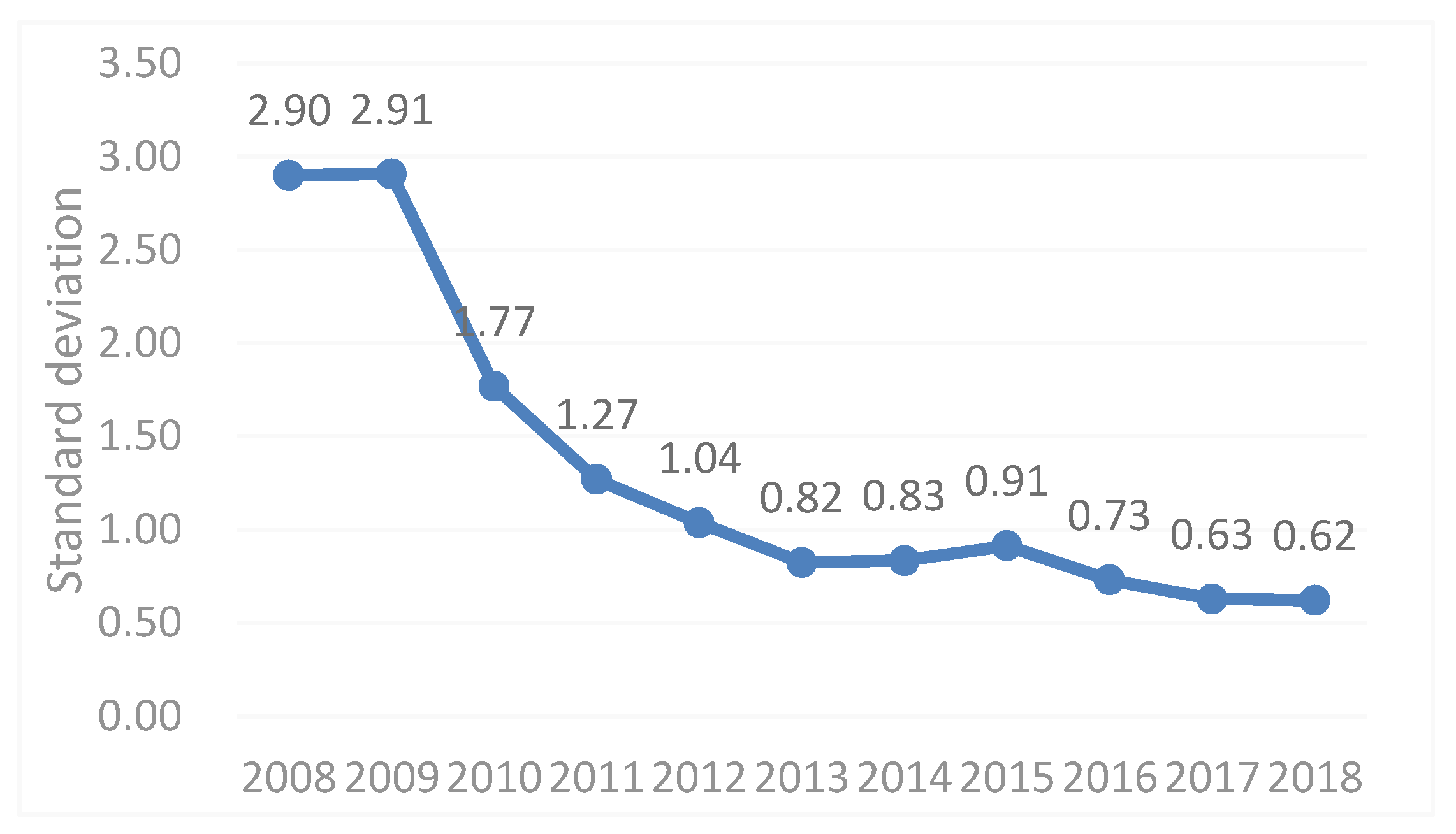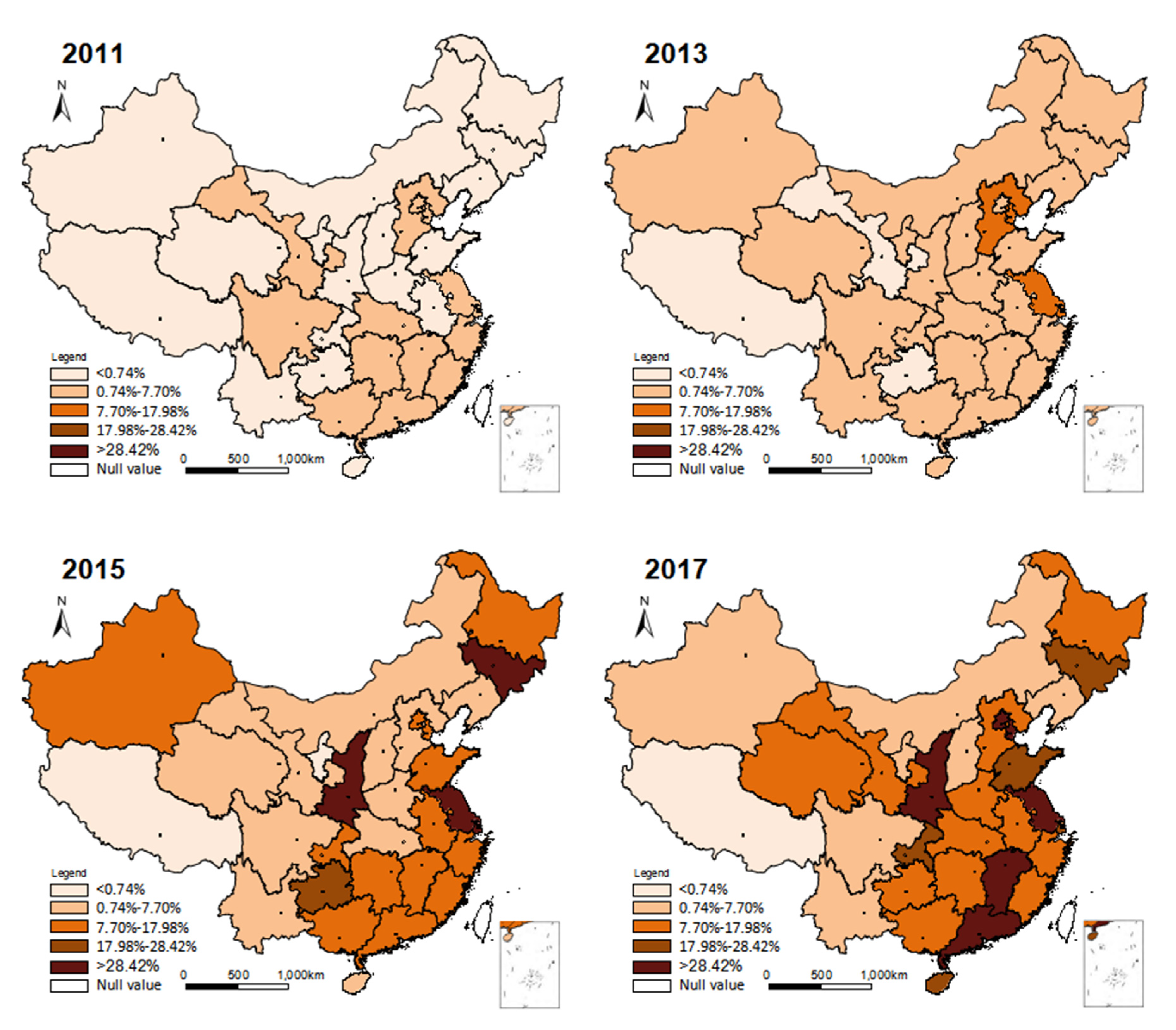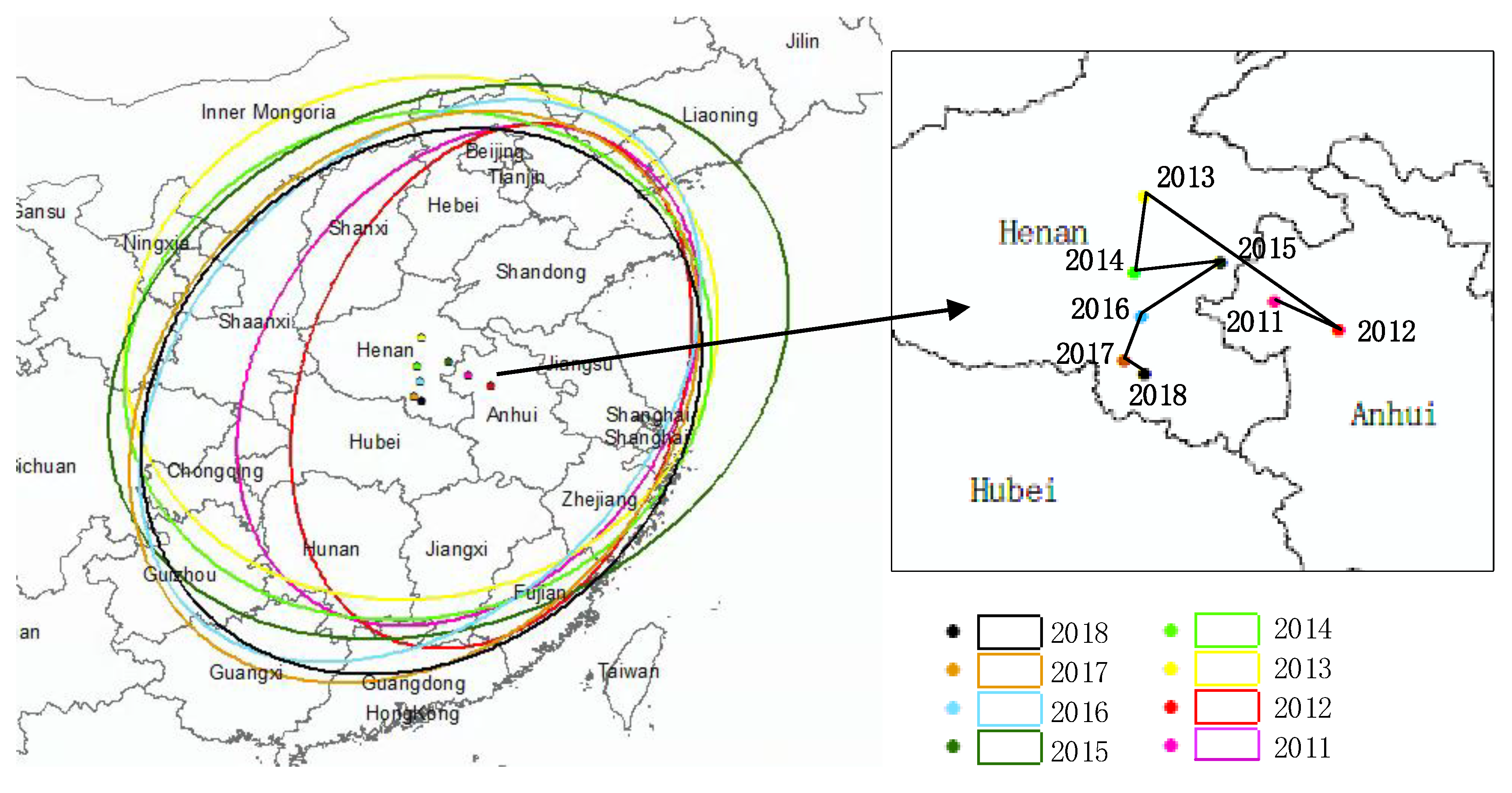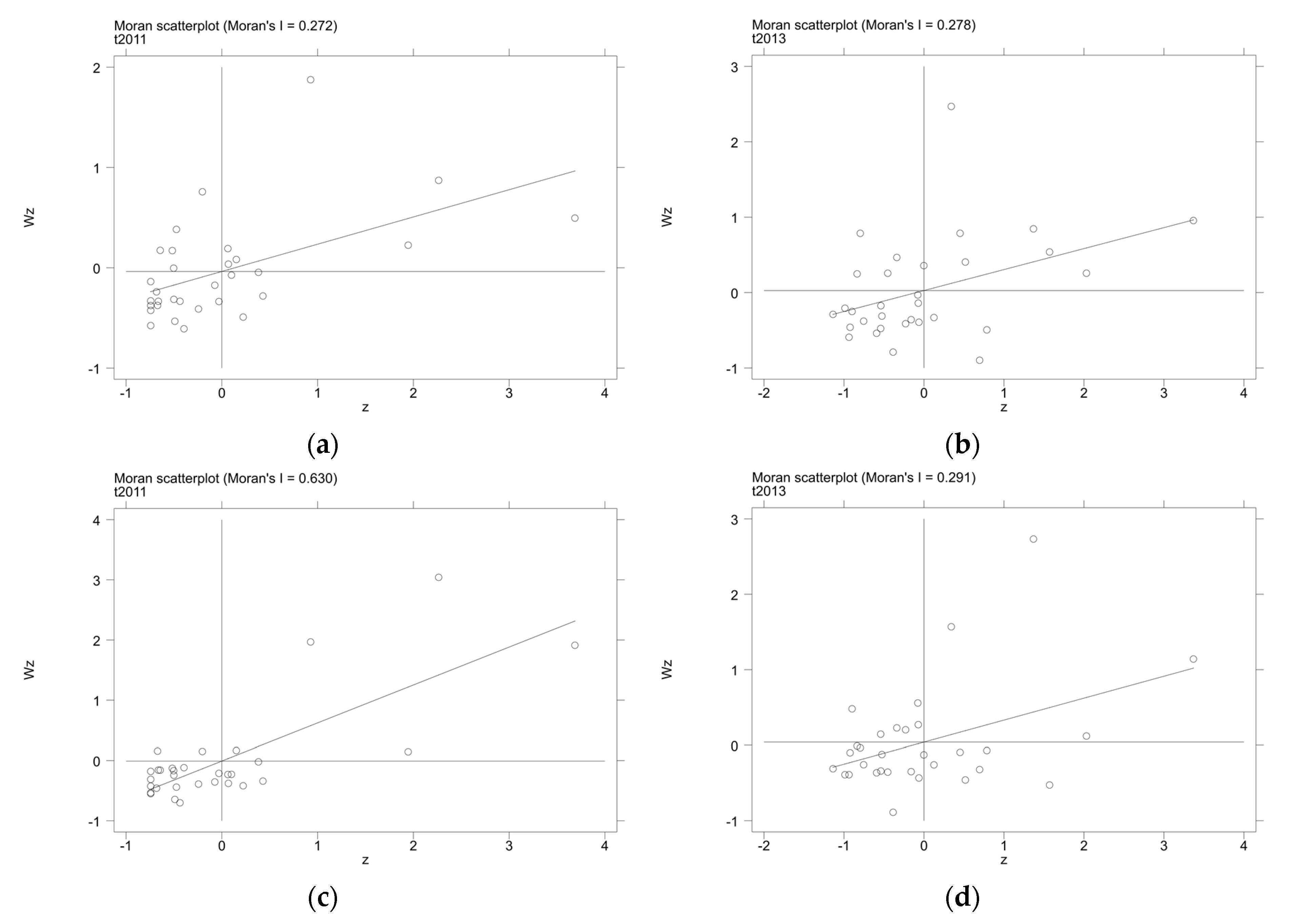Spatial-Temporal Evolution and Driving Factors of Green Building Development in China
Abstract
1. Introduction
2. Indexes and Methods
2.1. Indexes
2.2. Methods
2.2.1. Spatial Equilibrium
2.2.2. Spatial Distribution Characteristics
2.2.3. Spatial Correlation
2.2.4. Driving Factors
2.2.5. Geospatial Analysis Software
3. Spatial-Temporal Pattern Evolution of Green Buildings
3.1. Spatial Equilibrium of Green Building Development
3.1.1. Overall Spatial Equilibrium
3.1.2. Local Spatial Equilibrium
3.2. Spatial-Temporal Distribution Characteristics of Green Buildings
3.2.1. Center of Gravity of Green Buildings
3.2.2. Distribution Range of Green Buildings
3.2.3. Distribution Direction of Green Buildings
3.2.4. Distribution Shape of Green Buildings
3.3. Spatial Correlation of Green Buildings
4. Driving Factors of Green Building Development
5. Conclusions
Author Contributions
Funding
Conflicts of Interest
References
- IPCC. Climate Change 2007, the Fourth Assessment Report (AR4) of the United Nations Intergovernmental Panelon Climate Change; TERI: Geneva, Switzerland, 2008. [Google Scholar]
- No, S.; Won, C. Comparative Analysis of Energy Consumption between Green Building Certified and Non-Certified Buildings in Korea. Energies 2020, 13, 1049. [Google Scholar] [CrossRef]
- Technology and Industrialization Development Center of the Ministry of Housing and Urban-Rural Development. World Green Building Policy Law and Evaluation System; China Architecture & Building Press: Beijing, China, 2014; pp. 78–80.
- Qiu, Y.; Tiwari, A.; Wang, Y.D. The diffusion of voluntary green building certification: A spatial approach. Energy Effic. 2015, 8, 449–471. [Google Scholar] [CrossRef]
- Zhang, Y.; Wang, J.; Hu, F.; Wang, Y. Comparison of evaluation standards for green building in China, Britain, United States. Renew. Sustain. Energy Rev. 2017, 68 Pt 1, 262–271. [Google Scholar] [CrossRef]
- Darko, A.; Chan, A.P.C. Strategies to promote green building technologies adoption in developing countries: The case of Ghana. Build. Environ. 2018, 130, 74–84. [Google Scholar] [CrossRef]
- Olubunmi, O.A.; Xia, P.B.; Skitmore, M. Green building incentives: A review. Renew. Sustain. Energy Rev. 2016, 59, 1611–1621. [Google Scholar] [CrossRef]
- Chan, A.P.C.; Darko, A.; Ameyaw, E.E. Strategies for Promoting Green Building Technologies Adoption in the Construction Industry-An International Study. Sustainability 2017, 9, 969. [Google Scholar] [CrossRef]
- Hwang, B.-G.; Shan, M.; Phua, H.; Chi, S. An exploratory analysis of risks in green residential building construction projects: The case of Singapore. Sustainability 2017, 9, 1116. [Google Scholar] [CrossRef]
- Kats, G.; Alevantis, L.; Berman, A.; Mills, E.; Perlman, J. The Costs and Financial Benefeits of Green Buildings. In A Report to California’s Sustainable Building Task Force; California Department of Resources Recycling and Recovery: Sacramento, CA, USA, 2003; p. 134. Available online: http://www3.cec.org/islandora-gb/en/islandora/object/islandora%3A941 (accessed on 1 October 2003).
- Kaplan, S.; Matthiessen, L.; Morris, P.; Unger, R.; Sparko, A. Cost of Green in NYC; USGBC; Urban Green Council: New York, NY, USA, 2009; p. 10. [Google Scholar]
- Tollin, H.M. Green Building Risks: It’s not easy being green. Environ. Claims J. 2011, 23, 199–213. [Google Scholar] [CrossRef]
- Patrick, X.W.Z.; Couani, P. Managing risks in green building supply chain. Archit. Eng. Des. Manag. 2012, 8, 143–158. [Google Scholar]
- Madew, R. Green buildings: The easy answer for sustainability. Aust. Plan. 2007, 44, 16–17. [Google Scholar] [CrossRef]
- Švajlenka, J.; Kozlovská, M.; Pošiváková, T. Analysis of Selected Building Constructions Used in Industrial Construction in Terms of Sustainability Benefits. Sustainability 2018, 10, 4394. [Google Scholar] [CrossRef]
- Švajlenka, J.; Kozlovská, M. Evaluation of the efficiency and sustainability of timber-based construction. J. Clean. Prod. 2020. [Google Scholar] [CrossRef]
- Cidell, J.; Beata, A. Spatial variation among green building certification categories: Does place matter? A rejoinder to Pushkar. Landsc. Urban Plan. 2009, 91, 142–151. [Google Scholar] [CrossRef]
- Baoxing, Q. New Normal·New Green Building—The Current Situation and Development Prospect of Green Building in China. Constr. Sci. Technol. 2015, 12, 8–11. [Google Scholar]
- Kaza, N.; Lester, T.W.; Rodriguez, D.A. The Spatiotemporal Clustering of Green Buildings in the United States. Urban Stud. 2013, 16, 3262–3282. [Google Scholar] [CrossRef]
- Cidell, J. Building Green: The Emerging Geography of LEED Certified Buildings and Professionals. Prof. Geogr. 2009, 2, 200–215. [Google Scholar] [CrossRef]
- Fuerst, F.; Kontokosta, C.; McAllister, P. Taking the LEED? Analyzing Spatial Variations in Market Penetration Rates of Eco-Labeled Properties. Real Estate Plan. Work. Pap. 2011, 41, 551–570. [Google Scholar]
- Kahn, M.; Vaughn, R. Green Market Geography: The Spatial Clustering of Hybrid Vehicles and LEED Registeres Buildigs. BE J. Econ. Anal. Policy 2009, 9. [Google Scholar] [CrossRef]
- Baoxing, Q.; Donghong, L.; Zhiqiang, W. Study on the Character of Chinese Green Building Spatial Evolution. Urban Dev. Stud. 2017, 24, 1–10. [Google Scholar]
- Zou, Y.; Zhao, W.; Zhong, R. The spatial distribution of green buildings in China: Regional imbalance, economic fundamentals, and policy incentives. Appl. Geogr. 2017, 88, 38–47. [Google Scholar] [CrossRef]
- Large, R.O.; Thomsen, C.G. Drivers of green supply management performance: Evidence from Germany. J. Purch. Supply Manag. 2011, 17, 176–184. [Google Scholar] [CrossRef]
- Deng, Y.; Wu, J. Economic returns to residential green building investment: The developers’ perspective. Reg. Sci. Urban Econ. 2014, 47, 35–44. [Google Scholar] [CrossRef]
- Abidin, N.Z. Investigating the awareness and application of sustainable construction concept by Malaysian developers. Habitat. Int. 2010, 34, 421–426. [Google Scholar] [CrossRef]
- Ruparathna, R.; Hewage, K. Sustainable procurement in the Canadian construction industry: Current practices, drivers and opportunities. J. Clean. Prod. 2015, 109, 305–314. [Google Scholar] [CrossRef]
- Amstalden, R.W.; Kost, M.; Nathani, C.; Imboden, D.M. Economic potential energy-efficient retrofitting in the Swiss residential building sector: The effects of policy instruments and energy price expectations. Energy Policy 2007, 35, 19–29. [Google Scholar] [CrossRef]
- Zhang, L.; Chen, L.; Wu, Z. Investigation young consumers’ purchasing intention of green housing in China. Sustainability 2018, 10, 1044. [Google Scholar] [CrossRef]
- Maichum, K.; Parichatnon, S.; Peng, K.-C. Application of the extended theory of planned behavior model to investigate purchase intention of green products among thai consumers. Sustainability 2016, 8, 1077. [Google Scholar] [CrossRef]
- Yang, S.J.; Su, Y.K.; Wang, W. Research on developers’ green procurement behavior based on the theory of planned behavior. Sustainability 2019, 11, 2949. [Google Scholar] [CrossRef]
- Delmas, M.; Toffel, M.W. Stakeholders and environmental management practices: An institutional framework. Bus. Strategy Environ. 2004, 13, 209–222. [Google Scholar] [CrossRef]
- Sarkis, J.; Gonzalez-Torre, P.; Adenso-Diaz, B. Stakeholder pressure and the adoption of environmental practices: The mediating effect of training. J. Oper. Manag. 2010, 28, 163–176. [Google Scholar] [CrossRef]
- Henriques, I.; Sadorsky, P. The determinants of an environmentally responsive firm: An empirical approach. J. Environ. 1996, 30, 381–395. [Google Scholar] [CrossRef]
- Ürge-Vorsatz, D.; Danny Harvey, L.D.; Mirasgedis, S.; Levine, M.D. Mitigating CO2 emissions from energy use in the world’s buildings. Build. Res. Inf. 2007, 35, 392–393. [Google Scholar] [CrossRef]
- Karkanias, C.; Boemi, S.N.; Papadopoulos, A.M.; Tsoutsos, T.D.; Karagiannidis, A. Energy efficiency in the Hellenic building sector: An assessment of the restrictions and perspectives of the market. Energy Policy 2010, 38, 2276–2784. [Google Scholar] [CrossRef]
- Skea, J. Cold Comfort in a high Carbon Society. Build. Res. Inf. 2009, 1, 74–78. [Google Scholar] [CrossRef]
- Wackernagel, M.; Onsite, L.; Bello, P. National natural capital accounting with the ecological footprint concept. Ecol. Econ. 1999, 29, 375–390. [Google Scholar] [CrossRef]
- Zuda, Y. The Geography of Green Buildings in Chinese Cities. Mod. Urban Res. 2012, 27, 42–48. [Google Scholar]
- Likun, Z.; Qibin, Z.; Junsen, T. Space-time Pattern Evolution and Spatial Correlation Analysis of Green Building in China—Based on Time Series Data from 2008–2015. Sci. Technol. Manag. Res. 2018, 3, 253–260. [Google Scholar]
- Isa, M.; Rahman, M.M.G.M.A.; Sipan, I.; Hwa, T.K. Factors Affecting Green Office Building Investment in Malaysia. Procedia Soc. Behav. Sci. 2013, 105, 138–148. [Google Scholar] [CrossRef]
- Xinru, H. Research on Influencing Factors of Urban Green Building Development in the Context of Sustainable Development; Shenzhen University: Shenzhen, China, 2016. [Google Scholar]
- Chan, E.H.W.; Qian, Q.K.; Lam, P.T.I. The market for green building in developed Asian cities-the perspectives of building designers. Energy Policy 2009, 37, 3061–3070. [Google Scholar] [CrossRef]
- Yijun, Y.; Ronghui, X. FDI, Environmental Regulation and Green Total Factor Productivity Growth of China’s Industry: An Empirical Study Based on Luenberger Index. J. Int. Trade 2015, 8, 84–93. [Google Scholar]
- Lam, P.T.I.; Chan, E.H.W.; Poon, C.S. Factors affecting the implementation of green specifications in construction. J. Environ. Manag. 2010, 91, 654–661. [Google Scholar] [CrossRef] [PubMed]
- Cao, F.; Ge, Y.; Wang, J.F. Optimal discretization for geographical detectors-based risk assessment. GIScience Remote Sens. 2013, 50, 78–92. [Google Scholar] [CrossRef]
- Ei-Sharif, W.; Horowitz, M.J. Why financial promotions work: Leveraging energy efficiency value to promote superior products. Proc. ACEEE Summer Study Energy Effic. Build. 2000, 5, 557–567. [Google Scholar]
- Al-Thani, S.K.; Skelhorn, C.P.; Amato, A.; Koc, M.; Al-Ghamdi, S.G. Smart Technology Impact on Neighborhood Form for a Sustainable Doha. Sustainability 2018, 10, 4764. [Google Scholar] [CrossRef]
- Tokbolat, S.; Karaca, F.; Durdyev, S.; Nazipov, F.; Aidyngaliyev, I. Assessment of Green Practices in Residential Buildings: A Survey-Based Empirical Study of Residents in Kazakhstan. Sustainability 2018, 10, 4383. [Google Scholar] [CrossRef]
- Liu, Z.; Chen, K.; Peh, L.; Tan, K.W. A feasibility study of Building Information Modeling for Green Mark New Non-Residential Building (NRB): 2015 analysis. Energy Procedia 2017, 143, 80–87. [Google Scholar] [CrossRef]
- Yangjie, F.D. American Green Building Policies, Regulations and Evaluation System. Constr. Sci. Technol. 2011, 6, 56–57. [Google Scholar]
- Zuo, J.; Zhao, Z.Y. Green building research–current status and future agenda: A review. Renew. Sustain. Energy Rev. 2014, 30, 271–281. [Google Scholar] [CrossRef]
- Monfared, I.G.; Sharples, S. Occupants’ perceptions and expectations of a green office building: A longitudinal case study. Archit. Sci. Rev. 2011, 54, 344–355. [Google Scholar] [CrossRef]
- Li, M.; Wu, W.H.; Wu, G.D. Green Building Promotion Mechanism Based on Stakeholder Dynamic Game. J. Civ. Eng. Manag. 2017, 34, 20–26. [Google Scholar]





| Drivers | Factors | Definition | Data Sources |
|---|---|---|---|
| Government Regulation Measures | Regulations (RE) | Number of green building-related regulations | Peking university magic weapon website |
| Incentives (INC) | Whether to implement green building financial subsidies and plot ratio incentive policies | Provincial housing and construction bureau website | |
| Public Purchasing Attitude | Baidu Index (BD) | The proportion of users paying attention to green buildings to commercial housing | Baidu index website |
| Education Level (EDU) | EDUi = Pi1 × 6 + Pi2 × 9 + Pi3 × 12 + Pi4 ×16, Pi1, Pi2, Pi3, Pi4 represent the proportion of the employees whose education background is elementary, junior high, high, tertiary, and above, respectively. | China statistical yearbook | |
| Economic and Technological Environment | Technical Level (TEC) | R&D internal expenditure/GDP; Whether to set green building design standards | China statistical yearbook; Provincial housing and construction bureau website |
| Economic Level (GDP) | GDP per capita indicator | China statistical yearbook |
| Years | CV (Coefficient of Variation) | CR4 (Concentration Ratio of Top 4) | CR8 (Concentration Ratio of Top 8) | G (Spatial Gini Coefficient) |
|---|---|---|---|---|
| 2008 | 2.280213 | 0.838284 | 1.000000 | 0.350510 |
| 2009 | 2.573852 | 0.860018 | 0.997210 | 0.398468 |
| 2010 | 1.679797 | 0.583869 | 0.807012 | 0.304874 |
| 2011 | 1.324509 | 0.512246 | 0.692776 | 0.244545 |
| 2012 | 1.132941 | 0.442163 | 0.673106 | 0.199705 |
| 2013 | 0.865042 | 0.365547 | 0.564079 | 0.175363 |
| 2014 | 0.820792 | 0.354632 | 0.551861 | 0.122449 |
| 2015 | 0.959384 | 0.426735 | 0.591439 | 0.144222 |
| 2016 | 0.808787 | 0.318777 | 0.544913 | 0.171737 |
| 2017 | 0.723756 | 0.292637 | 0.521377 | 0.158440 |
| 2018 | 0.777502 | 0.337425 | 0.542185 | 0.158314 |
| Year | Ellipse Area/10,000 km2 | Center of Gravity Coordinates | Major Axes Standard Deviation/km | Minor Axes Standard Deviation/km | Rotation Angles |
|---|---|---|---|---|---|
| 2011 | 174.1071 | 33.1049° N, 115.7712° E | 1472.8020 | 579.1046 | 37.0358° |
| 2012 | 159.7028 | 32.7666° N, 116.5019° E | 639.7082 | 866.3833 | 20.9925° |
| 2013 | 242.3666 | 34.2856° N, 114.2957° E | 592.1388 | 858.5509 | 75.5887° |
| 2014 | 233.3927 | 33.4132° N, 114.1887° E | 942.8528 | 818.2798 | 74.8857° |
| 2015 | 287.9023 | 33.5296° N, 115.1566° E | 936.7298 | 793.1339 | 66.4003° |
| 2016 | 231.9770 | 32.9269° N, 114.2625° E | 1115.3453 | 821.6950 | 44.7617° |
| 2017 | 246.6239 | 32.4236° N, 114.0733° E | 718.4983 | 1027.7707 | 44.5859° |
| 2018 | 235.3773 | 32.2838° N, 114.2981° E | 777.2204 | 1010.1036 | 48.9784° |
| Year | Adjacency Matrix | Year | Economic Distance Matrix | ||||
|---|---|---|---|---|---|---|---|
| Moran’s I | Z | P-Value | Moran’s I | Z | P-Value | ||
| 2008 | 0.079 | 1.023 | 0.153 | 2008 | 0.057 | 0.838 | 0.201 |
| 2009 | 0.056 | 0.962 | 0.168 | 2009 | 0.550 | 6.417 | 0.000 |
| 2010 | 0.268 | 3.104 | 0.001 | 2010 | 0.448 | 5.008 | 0.000 |
| 2011 | 0.272 | 2.859 | 0.002 | 2011 | 0.630 | 6.381 | 0.000 |
| 2012 | 0.322 | 3.084 | 0.001 | 2012 | 0.405 | 3.908 | 0.000 |
| 2013 | 0.278 | 2.777 | 0.003 | 2013 | 0.291 | 2.966 | 0.002 |
| 2014 | 0.259 | 2.590 | 0.005 | 2014 | 0.346 | 3.451 | 0.000 |
| 2015 | 0.123 | 1.372 | 0.085 | 2015 | 0.058 | 0.820 | 0.206 |
| 2016 | 0.013 | 0.020 | 0.492 | 2016 | 0.077 | 0.952 | 0.171 |
| 2017 | 0.165 | 1.655 | 0.049 | 2017 | 0.052 | 0.731 | 0.232 |
| 2018 | 0.080 | 0.973 | 0.165 | 2018 | 0.035 | 0.600 | 0.274 |
| Detection Factors | 2012 | 2014 | 2016 | 2018 | High-Level Area | Mid-Level Area | Low-Level Area | |
|---|---|---|---|---|---|---|---|---|
| Government Regulation Measures | Regulations (RE) | 0.25 | 0.28 | 0.16 | 0.21 | 0.19 | 0.37 | 0.19 |
| Incentives (INC) | 0.04 | 0.09 | 0.14 | 0.17 | 0.36 | 0.19 | 0.06 | |
| Public Purchasing Attitude | Baidu Index (BD) | 0.24 | 0.23 | 0.25 | 0.26 | 0.30 | 0.38 | 0.61 |
| Education Level (EDU) | 0.34 | 0.51 | 0.24 | 0.18 | 0.61 | 0.25 | 0.27 | |
| Economic and Technological Environment | Technical Level (TEC) | 0.32 | 0.26 | 0.22 | 0.24 | 0.35 | 0.51 | 0.07 |
| Economic Level (GDP) | 0.59 | 0.56 | 0.34 | 0.34 | 0.18 | 0.44 | 0.09 | |
| Dominant Interaction Factor | RE ∩ GDP | RE ∩ TEC | RE ∩ EDU | RE ∩ EDU | EDU ∩ TEC | RE ∩ BD | RE ∩ EDU | |
| 0.83 | 0.89 | 0.76 | 0.77 | 0.87 | 0.85 | 0.93 | ||
© 2020 by the authors. Licensee MDPI, Basel, Switzerland. This article is an open access article distributed under the terms and conditions of the Creative Commons Attribution (CC BY) license (http://creativecommons.org/licenses/by/4.0/).
Share and Cite
Gao, Y.; Yang, G.; Xie, Q. Spatial-Temporal Evolution and Driving Factors of Green Building Development in China. Sustainability 2020, 12, 2773. https://doi.org/10.3390/su12072773
Gao Y, Yang G, Xie Q. Spatial-Temporal Evolution and Driving Factors of Green Building Development in China. Sustainability. 2020; 12(7):2773. https://doi.org/10.3390/su12072773
Chicago/Turabian StyleGao, Yi, Gaosheng Yang, and Qiuhao Xie. 2020. "Spatial-Temporal Evolution and Driving Factors of Green Building Development in China" Sustainability 12, no. 7: 2773. https://doi.org/10.3390/su12072773
APA StyleGao, Y., Yang, G., & Xie, Q. (2020). Spatial-Temporal Evolution and Driving Factors of Green Building Development in China. Sustainability, 12(7), 2773. https://doi.org/10.3390/su12072773




